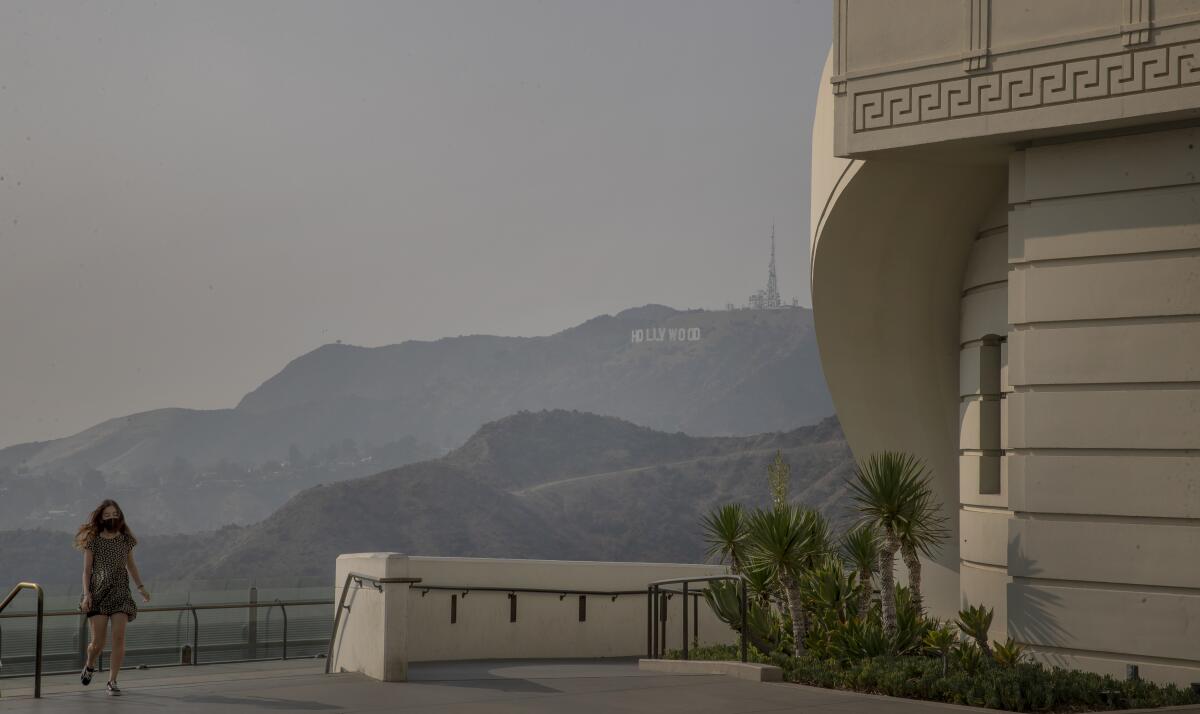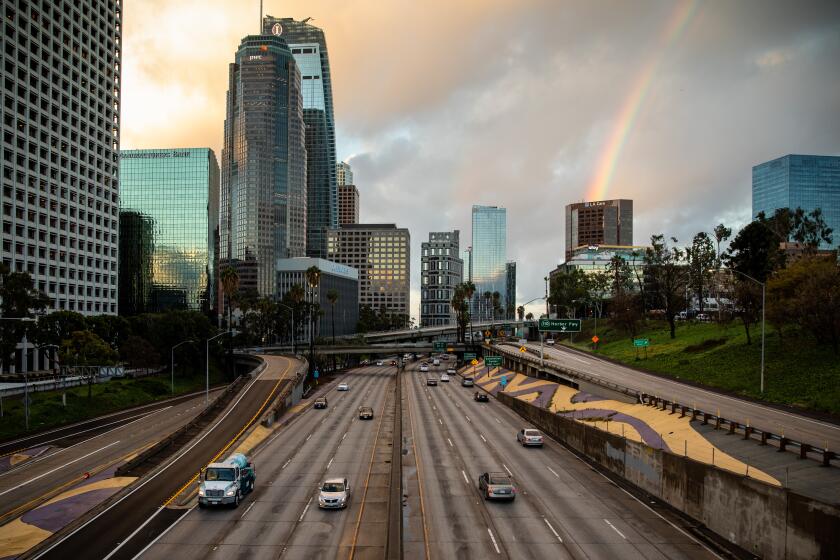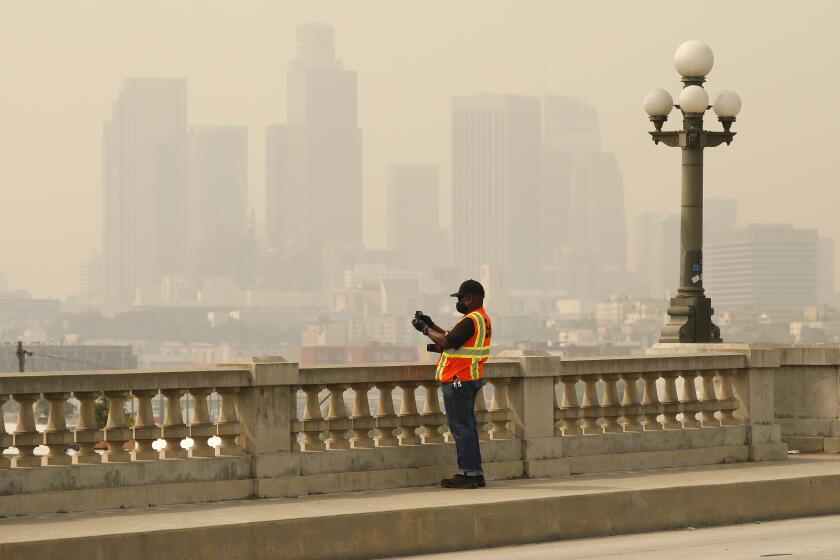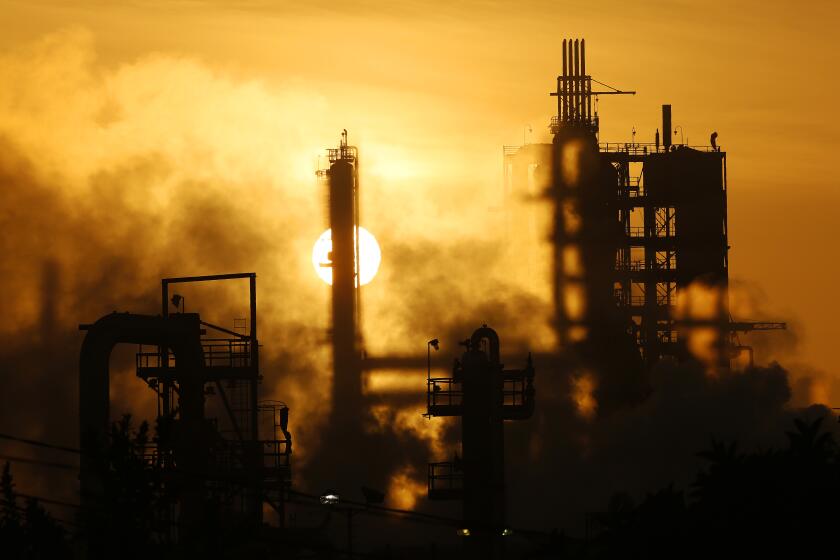L.A. began 2020 with a clean-air streak but ended with its worst smog in decades

- Share via
The year began with Los Angeles enjoying a 21-day stretch of smog-free days that overlapped with the start of coronavirus stay-at-home orders, fueling hopes that dramatic cuts in driving would at least clean the air.
That turned out to be wishful thinking. The year 2020 will instead go down as one of Southern California’s smoggiest in decades.
Once the air-cleansing March weather went away, the region plunged into a late spring and summer with intense heat waves that contributed to the worst ozone pollution readings and highest number of bad air days since the mid-1990s. Smog hit abnormally high levels throughout the region, from inland areas to the coast. By fall, the state had experienced the worst and most widespread bout of health-damaging wildfire smoke on record.
In all, this year there were 157 bad air days for ozone pollution — the invisible, lung-searing gas in smog — across the vast, coast-to-mountains basin spanning Los Angeles, Orange, Riverside and San Bernardino counties. That’s the most days above the federal health standard since 1997.
“There’s no sugarcoating it, this was a really, really bad ozone year,” said Philip Fine, a deputy executive officer for the South Coast Air Quality Management District.
The region has also had more than 30 bad air days for fine-particle pollution, or soot. Those numbers were boosted by a pall of smoke from local wildfires and blowing in from conflagrations up and down the West Coast. More bad air days are likely before the year’s end due to cool, pollution-trapping weather that concentrates soot near the ground.
The exceptionally poor air quality adds to a years-long trend of faltering progress reducing ozone, which triggers asthma attacks and other health problems. At the same time it has increased pressure on regulators to rein in ports, oil refineries and other big polluters and put the nation’s smoggiest region on a path to clean its air to federal health standards.
Coronavirus: L.A. clean air miracle has already come to an end. Here’s why
Scientists are working to understand the influence of climate change, wildfires, vehicle emissions and lesser-known pollution sources such as the fumes released by disinfectants and other consumer products. They said the pandemic gave them an unparalleled natural experiment, showing what happens when you drastically curtail one source of pollution. What became evident is that decades of regulations have cut passenger vehicle emissions so dramatically that they are no longer California’s dominant source of smog-forming pollution.
“We learned unambiguously that if you just take half the cars off the road, that cleans up the CO2 quite a lot, but CO2 doesn’t contribute to smog,” said Ronald Cohen, professor of atmospheric chemistry at UC Berkeley. “And that removing half the vehicles is not enough to control smog in L.A.”
“So you can’t just cut driving and stop smog, unfortunately,” Cohen said. “It’s possible that with cars we’ll only be clean enough when we go all electric.”
Extreme temperatures were a big reason why the air was so dirty. More than any fluctuation in emissions, heat is often what determines whether air quality will be unhealthy on any given day, because it fuels the photochemical reactions that form ozone. Air quality officials noted that temperatures were unusually high in the spring and fall, times of the year in which ozone pollution is typically lower than in the heat of the summer.
The highest ozone pollution level recorded in downtown Los Angeles in 26 years — a reading of 185 parts per billion — occurred during a blistering heat wave on Sept. 6, the same day L.A. County exceeded 120 degrees for the first time on record.
Air quality officials said the high pollution readings were a result of intense heat combined with stagnant weather conditions.
It is also possible that the response to the pandemic altered the mix of pollutants that generate ozone, which is not emitted directly, but forms when tailpipe emissions and other pollutants react in the heat and sunlight.
Reducing ozone requires carefully balanced cuts in two main smog-forming pollutants — combustion gases called nitrogen oxides and chemical vapors and solvents called volatile organic compounds — and regulators have long known that cutting them in the wrong proportion could bring no ozone reductions at all or even increase smog levels.
The South Coast air district estimates that emissions of nitrogen oxides were reduced by about 20% during stay-at-home orders that drastically reduced driving early in the pandemic, and have since mostly rebounded.
Air quality officials and scientists are focusing their attention on those other types of ozone-generating pollutants, volatile organic compounds, that can be released by everything from paint, hairspray and other consumer products to trees and plants. Those non-traffic emissions stayed constant or may have increased during the pandemic, and experts think they are playing a much more dominant role in smog formation than in years past.
“People expected with that level of traffic reductions, you’d have nothing but blue skies and fresh air, and clearly that didn’t happen,” said Michael Kleeman, a professor of civil and environmental engineering at UC Davis. “So it really does force you to think outside the conventional box.”
One theory that air quality regulators have floated is that the pandemic increased use of germ-fighting cleaners and disinfectants, many of which evaporate and release volatile organic compounds that can contribute to smog. Consumer products are the region’s largest single source of volatile organic compounds.
Fine, of the South Coast air district, said that “we don’t know what’s going on with the VOC emissions because it could be some drop due to less traffic, less activity. But also there’s just a lot of sales of disinfection equipment, and people are spraying things everywhere.”
Air monitor readings have not shown any significant increase in pollutants generated by cleaning chemicals, he said, but “people are using more of it, and it has the potential to increase VOC emissions. Now we don’t know whether that increase is negligible or whether that increase is significant. But we need to do more work on that.”
The year’s dirty air marks the latest setback to efforts to reduce smog in the nation’s most polluted region. Despite dramatic emissions reductions over decades, officials have failed to clean Southern California’s ozone pollution to federal air quality standards. The region still does not meet the health standard for ozone set more than 40 years ago when Jimmy Carter was president, or three stricter standards issued since.
Based on this year’s high smog readings alone, the South Coast air district said it will not be possible to meet the least stringent of those standards by a 2022 deadline.
In October, more than a dozen environmental groups and community organizations filed a petition urging the U.S. Environmental Protection Agency to determine that the South Coast region has failed to meet that standard and to require the air district to devise a control strategy that will protect public health, citing the harm to millions “forced to breathe this noxious air.”
Environmentalists said they are more broadly concerned that the region’s air quality agency seems to be taking its foot off the gas pedal at a time when smog reductions have stalled.
They point to delays in adopting major rules, including measures targeting oil refineries as well as warehouses and other hubs for diesel truck pollution. In some cases, the air district has cited the coronavirus as reason for holding off. But environmentalists say the district’s governing board, made up mostly of local politicians, is simply unwilling to take tough action to rein in pollution.
Powerful industries are pressuring California regulators to delay or roll back air quality and climate regulations due to the COVID-19 pandemic.
“We do see a political problem where the air district just isn’t doing their job,” said Regina Hsu, an attorney with the environmental law nonprofit Earthjustice. “This year, as we see one of the worst years for ozone pollution, there’s just been more and more delay of the regulations that communities have been asking for for years.”
Wayne Nastri, the South Coast air district’s executive officer, said it’s hard to say whether the recent increase in smog would motivate swifter action against the biggest polluters. He said the agency was moving aggressively to reduce emissions from refineries and warehouse logistic centers, among other facilities, and was committed to “doing everything we can, within our authority.”
Health experts said the smog increase couldn’t have come at a worse time, attacking people’s lungs during a pandemic in which respiratory health is paramount, when there is some evidence that people living in the most polluted areas are more susceptible to COVID-19.
“It’s one public health challenge on top of another,” said Yifang Zhu, a professor of environmental health sciences at UCLA Fielding School of Public Health.
Zhu said that air quality regulators need to factor into their decisions the reality that two major drivers of smog — wildfires and extreme temperatures — are getting worse because of climate change.
Hotter temperatures from global warming, in addition to fueling increases in wildfire emissions, make controlling smog more difficult by speeding up the photochemical reactions that form ozone pollution — something that Nastri said he thinks is now being borne out Southern California.
The South Coast air district is studying the role of climate change but has remained cautious about linking it to recent smog increases. Under current EPA protocols, pollution-reduction plans required under the Clean Air Act do not account for rising temperatures from climate change. Doing so would require tougher regulations and steeper emissions cuts, officials acknowledge.
In a presentation last month to its governing board, air district staff discussed the climate’s impacts on smog in hypothetical terms, saying that “if a changing climate causes these extreme weather and wildfire events to continue or get worse, attainment of future standards will be even more challenging.”
More to Read
Sign up for Essential California
The most important California stories and recommendations in your inbox every morning.
You may occasionally receive promotional content from the Los Angeles Times.














